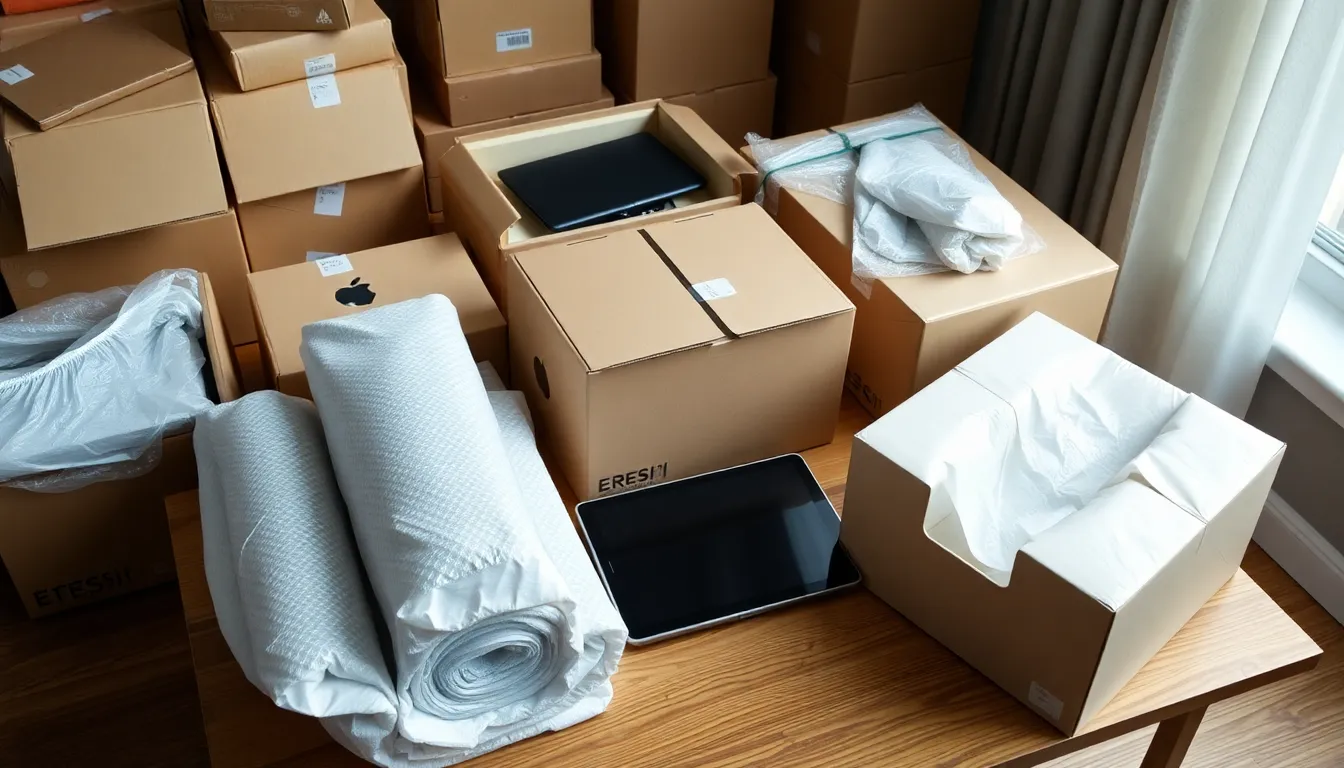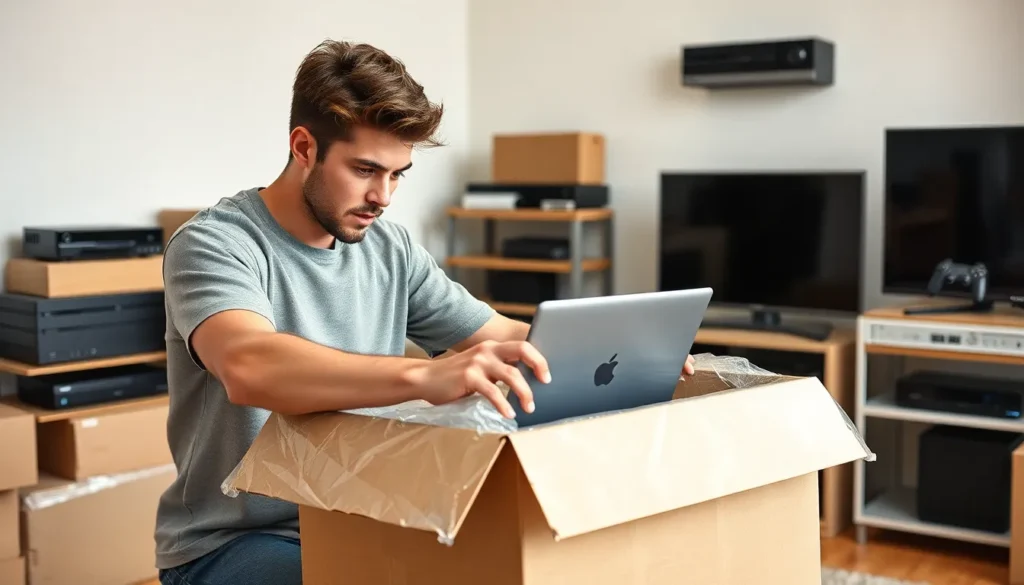Table of Contents
ToggleMoving can feel like a high-stakes game of Tetris, especially when it comes to packing up your beloved electronics. One wrong move and that delicate laptop or treasured gaming console could end up as a sad pile of circuitry. But fear not! With a little humor and a dash of strategy, packing your gadgets doesn’t have to be a disaster.
Importance of Proper Packing
Packing electronics requires attention to detail to prevent damage during a move. High-value items like laptops and gaming consoles face risks from bumps and jostles if not securely packed. Valuable components within devices, such as screens and drives, can easily sustain costly damage without proper protection.
Choosing the right packing materials significantly enhances protection. Bubble wrap or foam padding offers excellent cushioning, while sturdy boxes prevent crush damage. Labeling boxes clearly allows for easy identification, ensuring devices are handled correctly during transport.
Taking the time to back up data before packing is crucial. This step mitigates risks related to data loss, providing peace of mind. Disconnecting cables and organizing them can simplify setup in the new location.
Using original packaging, if available, improves safety. Manufacturers design these packages to suit the specific dimensions and fragility of devices. If original boxes are unavailable, custom-fitting materials can still safeguard valuable equipment.
Investing in overall organization enhances the moving experience. Grouping similar items together eases unpacking and setup in the new environment. Prioritizing electronics during the packing process helps manage the chaos that often accompanies moving.
Effective packing not only protects devices but also streamlines relocation tasks. A well-planned approach saves time and reduces stress, leading to a smoother transition into a new space.
Materials Needed for Packing Electronics

Packing electronics requires specific materials to ensure their protection during the move.
Boxes and Containers
Sturdy boxes offer essential support for electronics. They should be appropriately sized for each device, minimizing movement inside the box. Using the original packaging enhances safety, as it often includes customized cushioning. If original boxes aren’t available, consider using new boxes made from durable materials. Additionally, utilizing containers with reinforced edges helps to prevent damage from impacts. A well-sized box prevents jostling, which is crucial for fragile equipment.
Protective Materials
Foam padding acts as a barrier against shocks and vibrations. Wrapping devices with bubble wrap provides extra cushioning, reducing the risk of scratches and dents. Packing peanuts can fill empty spaces in boxes, preventing movement during transport. Consider using anti-static bubble wrap specifically for electronics to prevent static damage. Soft cloths or towels can also be effective in offering surface protection for screens and delicate components. Investing in proper protective materials greatly increases the chance that electronics arrive at the new location unscathed.
Steps for Packing Electronics
Packing electronics requires careful attention to detail. Each step plays a crucial role in ensuring devices arrive safely at the new location.
Preparation of Electronics
Start by backing up important files stored on devices. Disconnect all accessories like chargers, mice, and keyboards. It’s beneficial to clean each device to remove dust and debris, as this helps maintain their condition. Gather original packaging when possible; these materials often provide the best protection. Create an inventory list of all items being moved to keep track of devices.
Disconnection and Organization
Organizing cables can simplify the unpacking process. Labeling each cable with tags helps identify connections easily, reducing confusion later on. Store smaller accessories in separate pouches to avoid misplacement, ensuring everything is accounted for. When disconnecting devices, take photographs of the setup to serve as a reference when reassembling. This visual guide speeds up the reconnection process, allowing immediate enjoyment of devices in the new space.
Wrapping and Cushioning
Wrap each electronic device individually with bubble wrap or foam. This cushioning protects against jostles and impacts during the move. Ensure screens are shielded with soft cloths or specialized anti-static materials to prevent scratches. Sturdy boxes should be used for packing; they prevent movement and potential damage. Fill any gaps in the box with packing peanuts or crumpled paper to minimize shifting of devices during transport. Proper wrapping and cushioning techniques significantly enhance the likelihood of damage-free arrival.
Tips for Specific Electronics
Packing electronics requires special attention to detail. Each device presents unique challenges that ensure proper protection during a move.
Packing Computers and Laptops
Start by removing any accessories from the computer. Disconnect power cords and peripherals like mice and keyboards. Use original boxes if available; otherwise, use sturdy, appropriately sized boxes. Wrap the laptop in bubble wrap for added cushioning and place it in the box with protective materials on all sides. Fill gaps with packing peanuts or crumpled paper to prevent movement during transport. Create a list of all items packed to simplify unpacking and reassembling.
Packing TVs and Monitors
For TVs and monitors, ensure the screen is protected before packing. Use a soft cloth to clean the screen and then wrap it in anti-static bubble wrap. Place the device in its original box if possible; if not, select a box that fits snugly. Include foam padding or cardboard corners for extra protection. Label the box clearly with “Fragile” to ensure careful handling during transport. Secure all cables and accessories in a separate bag taped to the box for easy access upon arrival.
Packing Audio and Video Equipment
Begin with carefully removing all cables from audio and video equipment. Group similar items together for organized packing. Wrap equipment like speakers or receivers in thick blankets or bubble wrap to prevent scratches. Pack these devices in sturdy boxes with padding on all sides. Place small accessories, such as remote controls or cables, in labeled bags or boxes for easy identification. Maintaining an inventory as you pack helps track all items, reducing the risk of missing pieces when unpacking.
Packing electronics doesn’t have to be a daunting task. With the right approach and materials it’s possible to keep devices safe and secure during a move. Attention to detail and organization play crucial roles in ensuring everything arrives intact.
By using sturdy boxes and protective materials like bubble wrap and foam padding, it’s easier to prevent damage. Clear labeling and proper inventory management simplify the unpacking process, making it less stressful.
Taking the time to prepare devices and gather necessary supplies pays off in the end. A smooth transition to a new space is achievable with careful planning and execution, allowing for a fresh start without the worry of damaged electronics.





